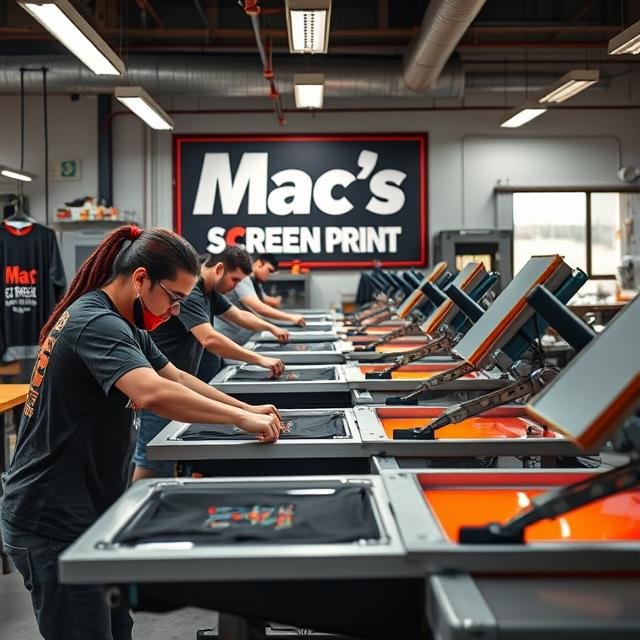When it comes to custom apparel and merchandise, screen printing has remained one of the most trusted and widely used methods for decades. Among the businesses that specialize in this craft, Mac’s Screen Printing has become a recognizable name for people looking to bring their ideas to life on fabric and other surfaces. Whether you’re new to the world of screen printing or simply curious about how companies like Mac’s operate, this detailed article explores the techniques, history, benefits, and applications of screen printing in modern times.
Table of Contents
What Is Screen Printing?
Screen printing, also called silk screening, is a printing technique where ink is pushed through a mesh stencil onto a surface—most commonly fabric, but also paper, wood, metal, and plastic. The stencil, or “screen,” determines the design, and each color in the design requires a separate screen.
The method is especially popular for custom t-shirts, sports jerseys, tote bags, and promotional items. Companies such as Mac’s Screen Printing use this process because it produces durable, vibrant, and professional-quality results that other printing methods often struggle to match.
A Brief History of Screen Printing
Screen printing has roots in ancient China, where stencils were first used to transfer images onto fabric. The technique spread to Japan and later reached Europe in the 18th century. It wasn’t until the 20th century, however, that screen printing became widely used for commercial purposes.
By the 1960s and 1970s, the method had gained artistic recognition as well, with famous pop artists such as Andy Warhol using screen printing to create iconic works. Today, businesses like Mac’s Screen Printing continue the legacy, blending traditional craftsmanship with modern technology to serve communities, schools, organizations, and entrepreneurs.
The Screen Printing Process
Mac’s Screen Printing, like many professional shops, follows a step-by-step process to ensure each print meets high-quality standards. Here’s a closer look at the stages involved:
1. Design Creation
The first step is creating or refining the artwork. Digital design software is used to prepare the file and separate colors since each color requires its own screen.
2. Screen Preparation
A mesh screen is coated with a light-sensitive emulsion. The design is then transferred onto the screen using ultraviolet (UV) light, leaving behind open areas where ink can pass through.
3. Ink Application
The prepared screen is placed on the printing surface. Ink is poured onto the screen and a squeegee pushes it across, forcing ink through the open mesh onto the material below.
4. Drying and Curing
To ensure durability, the printed material is sent through a dryer or heat press, which cures the ink and makes it resistant to washing and wear.
5. Finishing Touches
Some prints may undergo additional treatments, such as special coatings, to enhance their appearance or longevity.
Why Choose Screen Printing Over Other Methods?
Businesses like Mac’s Screen Printing thrive because the method has unique advantages compared to alternatives like digital printing, vinyl, or sublimation.
- Durability: Screen-printed designs last longer, even after multiple washes.
- Vibrant Colors: The inks used in screen printing are thick and bold, making designs pop.
- Cost-Effective for Bulk Orders: Large runs are more economical compared to digital printing.
- Versatility: Screen printing works on many materials, from cotton and polyester to wood and metal.
- Special Effects: Techniques like puff ink, metallic finishes, and glow-in-the-dark prints can be achieved with screen printing.
The Role of Mac’s Screen Printing in Communities
While the technical process is fascinating, the real impact of a business like Mac’s lies in its service to the community. Many local screen-printing shops don’t just cater to individuals—they support schools, sports teams, nonprofits, small businesses, and events.
- Schools and Teams: From spirit wear to sports jerseys, screen printing helps build identity and pride.
- Events and Fundraisers: Custom t-shirts for charity runs, concerts, or festivals create a sense of unity and lasting memories.
- Businesses: Local companies use screen printing for employee uniforms, promotional giveaways, and branded merchandise.
- Artists and Entrepreneurs: Aspiring clothing brands and artists often partner with screen printers to launch products without investing in expensive equipment.
Common Products Made at Mac’s Screen Printing
Though t-shirts remain the most common product, the versatility of screen printing extends much further. At Mac’s, customers often order:
- Hoodies and sweatshirts
- Caps and hats
- Tote bags and backpacks
- Jackets and outerwear
- Posters and art prints
- Custom promotional items
This variety demonstrates the flexibility and enduring appeal of the craft.
Challenges and Innovations in Screen Printing
Even a time-tested process like screen printing faces challenges. Environmental concerns, such as ink waste and water usage, have pushed companies like Mac’s to adopt eco-friendly practices. Many shops now use water-based or plastisol-free inks, recycle materials, and invest in energy-efficient equipment.
Technology has also improved the process. Automated screen printing presses can handle higher volumes at faster speeds, while digital design software ensures greater accuracy in artwork preparation.
The Future of Screen Printing
With the rise of e-commerce and personalized fashion, screen printing remains in demand. Companies like Mac’s Screen Printing are positioned to grow by blending tradition with innovation—offering high-quality, hand-crafted results while embracing sustainable practices and digital ordering systems.
As customization becomes a key trend in modern retail, screen printing will continue to be a vital method for creating unique, long-lasting products.
FAQs About Mac’s Screen Printing
Q1: What types of materials can be screen printed at Mac’s Screen Printing?
Screen printing works on cotton, polyester, blends, wood, paper, and even some plastics or metals.
Q2: How many colors can be used in a screen-printed design?
Each color requires a separate screen, so multi-color designs are possible but may increase setup costs.
Q3: Is screen printing eco-friendly?
Many shops, including Mac’s, now use eco-friendly inks and materials to reduce their environmental impact.
Q4: How long does a screen-printed design last?
With proper care, screen-printed designs can last for years without fading or cracking.
Q5: Is screen printing better than digital printing?
It depends on the project. Screen printing is ideal for bulk orders and bold designs, while digital printing is better for small runs and detailed images.
Q6: Can individuals place small orders at Mac’s Screen Printing?
Yes, but larger orders are often more cost-effective. Many shops balance both small custom requests and large bulk orders.
Q7: How does Mac’s Screen Printing support local communities?
By providing custom apparel for schools, fundraisers, sports teams, and small businesses, Mac’s fosters local identity and unity.
Conclusion
Mac’s Screen Printing represents more than just a printing service—it’s part of a tradition that combines creativity, craftsmanship, and community service. From producing durable, vibrant apparel to supporting local events and businesses, screen printing remains a cornerstone of custom design and branding. As the industry evolves, companies like Mac’s continue to adapt, ensuring the method’s relevance for generations to come.

